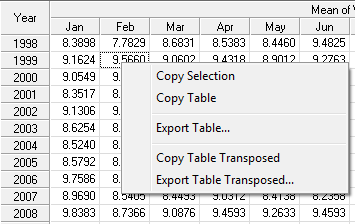
| Daily, Monthly, Quarterly and Annual Statistics Tables |  |
These four tables allow you to view statistics for a given data column for the selected calendar period. You can create them on the Tables window of Windographer's main window.
This table shows for each period, for the data column you have selected:
For wind speed data columns, it also shows the best-fit Weibull parameters.
For wind direction data columns, Windographer calculates the vector means for each month, and the other statistics are scalar calculated values as clarified in the table. Note that there could be fewer data points in the vector mean calculation than in the scalar calculations because a valid wind speed measurement is required.
For example, in the dataset shown below, in October 2001 there are 735 data points that contain both wind direction data and the associated wind speed data. (You can specify the associated wind speed data column from the Configure Dataset window, or specify '<None>' for unit vectors.) But when you look at only the direction data to calculate the mean, min, max and Std. Dev, there are 744 valid data points.

Tip:The dataset's period of record affects the number of possible data points in the first and last month of the dataset. If a five-month data set ends after the first week of February, for example, its number of possible data points in February will equate to only a quarter of the total number of time steps in February.
You can see the mean daily values in graphical form on the Time Series window by choosing the Daily Means option. Note that the time series graph will not display daily means for days whose data recovery rate falls below the minimimum data coverage settings.
If you check the checkbox labeled Combine years together, the table will collapse to show one row for each month of the year and any summary rows. In this case, the January row will represent all January data in the dataset, the February row all February data in the dataset, and so on. If you do not check the checkbox, the table will contain as many rows as there are months in the dataset, plus any summary rows. In this case, Windographer calculates and displays the January 2004 statistics separately from the January 2005 statistics, for example.
The Monthly Statistics Table also appears in the Data Column Report, which you can create on the Reports tab.
You can see the mean monthly values in graphical form on the Time Series window by choosing the Monthly Means option. Note that the time series graph will not include monthly values if the data recover rate is below minimimum data recovery rate as specified in the Tools > Options > Average setting.
Monthly information is also shown in a different format in these other tables:
Windographer defines quarters as follows:
You can see the annual mean values in graphical form on the Time Series window by choosing the Annual Means
This Annual Statistics Table also appears in the Data Column Report, which you can create on the Reports tab.
Annual information is also shown in a different format in the Statistics by Year and Month table
Note that these and other annual statistics can be calculated with the Long Term Trends window, and viewed in graphical or tabular form.
The Filter by section allows you to create a statistical report for a subset of your data. The date filter is disabled for the annual table. For more information see the article on filtering data.
Use the Export Table button to export the table to a text file, or right click on the table to export it or to copy its contents to the clipboard:

See also